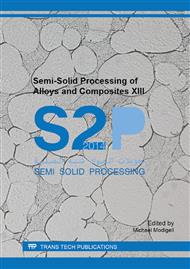p.332
p.340
p.347
p.355
p.361
p.366
p.374
p.381
p.389
Development of New Type Semi-Solid Injection Process for Magnesium Alloy
Abstract:
We have developed new type semi-solid injection process for magnesium alloy. This process does not require to use any cover gases and the special magnesium billet such as thixo-billet. In this study, plate specimens were produced by injecting the semi-solid billet with different fraction solid. The microstructure observation, detection of casting defects by an X-ray computed tomography scanner, and tensile test were carried out. With increasing fraction solid, the size and shape of α-Mg solid particles became smaller and more spherical. In the condition of low fraction solid or forming in liquid state, the casting defects were located in the center of the specimen at the thickness direction. Additionally, the volume fraction of the casting defect decreased with increasing fraction solid. Moreover, the casting defects can be reduced by preventing solidifying and clogging of the top of the nozzle. Then, the specimen which has few casting defects could be obtained by injecting the slurry of fraction solid 0.5. However, the tensile strength and yield strength were highest in fraction solid 0.4. It is contemplated that the composition of the solid solution component element in the matrix was increased in fraction solid of 50%, therefore the matrix became brittle.
Info:
Periodical:
Pages:
361-365
Citation:
Online since:
September 2014
Authors:
Keywords:
Price:
Сopyright:
© 2015 Trans Tech Publications Ltd. All Rights Reserved
Share:
Citation:


